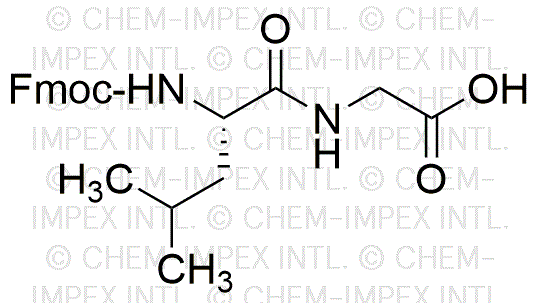Fmoc-Leu-Gly-OH is widely utilized in research focused on:
- Peptide Synthesis: This compound serves as a key building block in the synthesis of peptides, allowing researchers to create specific sequences for studying protein functions and interactions.
- Drug Development: It plays a significant role in the pharmaceutical industry for developing peptide-based drugs, which can lead to more targeted therapies with fewer side effects compared to traditional medications.
- Bioconjugation: Fmoc-Leu-Gly-OH is used in bioconjugation processes, enabling the attachment of biomolecules to surfaces or other compounds, which is essential in creating biosensors and diagnostics.
- Research in Cancer Therapy: Researchers utilize this compound to develop peptide therapeutics that can specifically target cancer cells, enhancing the efficacy of treatment while minimizing damage to healthy tissues.
- Protein Engineering: The compound aids in the modification of proteins, allowing scientists to study structure-function relationships and improve the stability and activity of therapeutic proteins.
General Information
Properties
Safety and Regulations
Applications
Fmoc-Leu-Gly-OH is widely utilized in research focused on:
- Peptide Synthesis: This compound serves as a key building block in the synthesis of peptides, allowing researchers to create specific sequences for studying protein functions and interactions.
- Drug Development: It plays a significant role in the pharmaceutical industry for developing peptide-based drugs, which can lead to more targeted therapies with fewer side effects compared to traditional medications.
- Bioconjugation: Fmoc-Leu-Gly-OH is used in bioconjugation processes, enabling the attachment of biomolecules to surfaces or other compounds, which is essential in creating biosensors and diagnostics.
- Research in Cancer Therapy: Researchers utilize this compound to develop peptide therapeutics that can specifically target cancer cells, enhancing the efficacy of treatment while minimizing damage to healthy tissues.
- Protein Engineering: The compound aids in the modification of proteins, allowing scientists to study structure-function relationships and improve the stability and activity of therapeutic proteins.
Documents
Safety Data Sheets (SDS)
The SDS provides comprehensive safety information on handling, storage, and disposal of the product.
Product Specification (PS)
The PS provides a comprehensive breakdown of the product’s properties, including chemical composition, physical state, purity, and storage requirements. It also details acceptable quality ranges and the product's intended applications.
Certificates of Analysis (COA)
Search for Certificates of Analysis (COA) by entering the products Lot Number. Lot and Batch Numbers can be found on a product’s label following the words ‘Lot’ or ‘Batch’.
Numéro de catalogue
Numéro de lot/série
Certificates Of Origin (COO)
This COO confirms the country where the product was manufactured, and also details the materials and components used in it and whether it is derived from natural, synthetic, or other specific sources. This certificate may be required for customs, trade, and regulatory compliance.
Numéro de catalogue
Numéro de lot/série
Safety Data Sheets (SDS)
The SDS provides comprehensive safety information on handling, storage, and disposal of the product.
DownloadProduct Specification (PS)
The PS provides a comprehensive breakdown of the product’s properties, including chemical composition, physical state, purity, and storage requirements. It also details acceptable quality ranges and the product's intended applications.
DownloadCertificates of Analysis (COA)
Search for Certificates of Analysis (COA) by entering the products Lot Number. Lot and Batch Numbers can be found on a product’s label following the words ‘Lot’ or ‘Batch’.
Numéro de catalogue
Numéro de lot/série
Certificates Of Origin (COO)
This COO confirms the country where the product was manufactured, and also details the materials and components used in it and whether it is derived from natural, synthetic, or other specific sources. This certificate may be required for customs, trade, and regulatory compliance.


